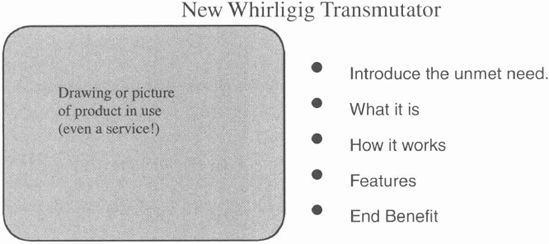18.8. Concept Testing: "Which of Our Raw Ideas are the Most Promising to Pursue?"
Many companies use a haphazard and incomplete process for picking the new product ideas they will develop into new products. A better way is to test all the company's wild and crazy ideas in an inexpensive and quick manner. This ensures that no potential winner is discarded.
A concept is a statement about anticipated product features that will yield selected benefits relative to other products already available (Crawford and DiBenedetto, 1999). Any company, consumer or business-to-business, selling physical products or services, high-tech or low-tech, can craft its raw new product ideas into full concepts. Concepts are usually 100-150 words long and contain a simple picture or drawing. Figure 18.5 shows a good way of formatting concepts.
It is usually a good idea not to put a price on these early ideas, because the goal of concept testing is to get a read on customer interest in the general idea. If the idea tests well, there's plenty of time later to investigate price (and better tools—see Conjoint Analysis later in this chapter).
Figure 18-5. CONCEPT-WRITING TEMPLATE.

Once 10-30 concepts are created, it is time to get them in front of customers to see their reaction. The questions to ask are on the order of "if you could buy/use such a product, how likely would you?" A five-point scale is usually ...
Get The PDMA Handbook of New Product Development now with the O’Reilly learning platform.
O’Reilly members experience books, live events, courses curated by job role, and more from O’Reilly and nearly 200 top publishers.

